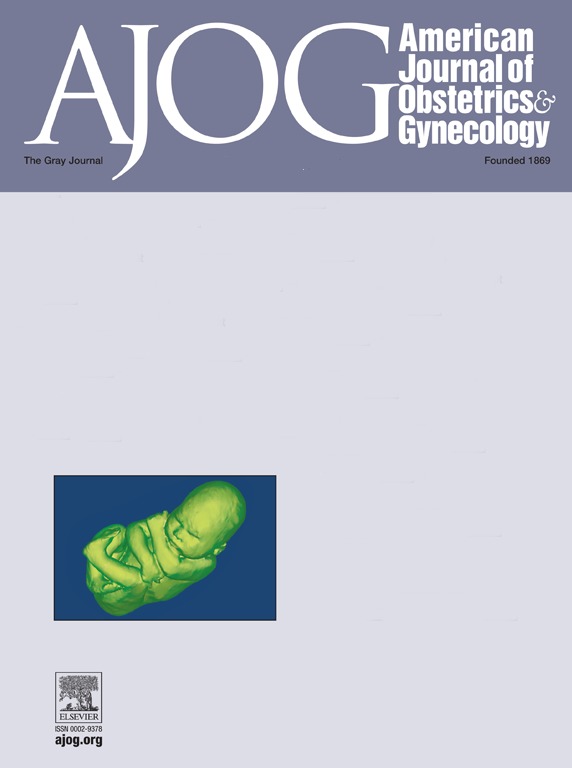美国和加拿大产后一年内并发症的频率和时间:一项系统回顾和荟萃分析。
IF 8.7
1区 医学
Q1 OBSTETRICS & GYNECOLOGY
引用次数: 0
摘要
目的了解产后并发症的发生率和发生时机,有助于及时筛查和处理,降低可预防的发病率和死亡率。本研究的目的是总结美国和加拿大从医院分娩到产后一年并发症的频率(患病率或发生率)和时间。数据来源pubmed MEDLINE、Web of Science、EBSCO CINAHL、Cochrane CENTRAL和系统评价数据库的检索时间为2010年1月1日至2024年12月31日。研究资格标准:纳入标准是用英文撰写的研究,报告美国和加拿大成人从医院分娩到产后1年的医疗、手术/手术和心理并发症的频率和时间。少于100例患者,未报告评估时间,或仅包括具有特定医学状况(如先兆子痫)的患者的研究被排除在外。研究评价和综合方法数据筛选、提取和评价由两位审稿人完成。评估工具是乔安娜布里格斯研究所用于报告患病率数据的研究工具。如果在两个或两个以上的研究中报告了并发症,则使用随机效应模型进行meta分析。结果在4874篇检索文献中,共纳入117篇(93篇原始调查,24篇综述)。原始调查研究的总样本量为246,521,464例患者(中位数(四分位数范围)为6,030例(每项研究513至327,066例))。总共提取了41例并发症和死亡率数据,在定义和测量时间点之间存在显著的异质性。通过荟萃分析(95%置信区间),产后一年的频率估计为焦虑1380(845 - 2174),抑郁1008(749 - 1343),高血压890(345 - 2109),强迫症996(134 - 4089),出血591(454 - 763),创伤后应激障碍464(188 - 1100),手术感染581(12 - 7678),产后严重产妇发病率100(38 - 260),静脉血栓栓塞17(13 - 24),败血症11 (8 - 15),心肌病1.9(0.5 - 6.8),严重败血症1.2(0.2 - 9.0),心脏骤停0.9(0.2 - 1.0),急性心肌梗死0.25(0.06 - 1.03),死亡率1.2(0.3 - 5.6)。结论我们报告了41例并发症的发生频率和时间,以及从分娩到产后1年的死亡率。在接受荟萃分析的9种并发症中,最常见的是焦虑、抑郁、高血压和出血。这些结果可以为基于证据的资源分配提供信息,并指导优化产后监测和护理路径的制定。本文章由计算机程序翻译,如有差异,请以英文原文为准。
Frequency and timing of complications within the first postpartum year in the United States and Canada: A systematic review and meta-analysis.
OBJECTIVE
Understanding the rates and timing of postpartum complications can facilitate timely screening and management to reduce preventable morbidity and mortality. The aim of this study was to summarize the frequency (prevalence or incidence) and timing of complications from hospital delivery to one year postpartum in the United States and Canada.
DATA SOURCES
PubMed MEDLINE, Web of Science, EBSCO CINAHL, and the Cochrane CENTRAL and Database of Systematic Reviews were reviewed from January 1, 2010, until December 31, 2024.
STUDY ELIGIBILITY CRITERIA
Inclusion criteria were studies written in English reporting the frequency and timing of medical, procedural/surgical, and psychosocial complications in adults in the United States and Canada, from hospital delivery to 1 year postpartum. Studies with less than 100 patients, not reporting the timing of evaluation, or only included patients with a specific medical condition (e.g. preeclampsia) were excluded.
STUDY APPRAISAL AND SYNTHESIS METHODS
Data screening, extraction, and appraisal were performed by two reviewers. The appraisal tool was the Joanna Briggs Institute instrument for studies reporting prevalence data. Meta-analysis using random effects modelling was performed if a complication was reported in two or more studies.
RESULTS
Out of 4874 retrieved articles, 117 were included (93 original investigations, 24 reviews). The total sample size from original investigation studies was 246,521,464 patients (median (interquartile range) 6,030 (513 to 327,066) per study). In total, 41 complications and mortality data were extracted, with significant heterogeneity amongst definitions and time points of measurements. The one-year postpartum frequency estimates from meta-analysis (per 10,000, with 95% confidence interval) were anxiety 1,380 (845 - 2,174), depression 1008 (749 - 1,343), hypertension 890 (345 - 2,109), obsessive compulsive disorder 996 (134 - 4,089), hemorrhage 591 (454 - 763), post-traumatic stress disorder 464 (188 - 1,100), surgical infection 581 (12 - 7,678), postpartum severe maternal morbidity 100 (38 - 260), venous thromboembolism 17 (13 - 24), sepsis 11 (8 - 15), cardiomyopathy 1.9 (0.5 - 6.8), severe sepsis 1.2 (0.2 - 9.0), cardiac arrest 0.9 (0.2 to 1.0), acute myocardial infarction 0.25 (0.06 - 1.03), and mortality 1.2 (0.3 - 5.6).
CONCLUSIONS
We report frequencies and timings for 41 complications and mortality from delivery to one year postpartum. Of the nine complications that underwent meta-analysis, anxiety, depression, hypertension and hemorrhage were reported most frequently. These results can inform evidence-based resource allocation and guide optimal postpartum monitoring and care pathway development.
求助全文
通过发布文献求助,成功后即可免费获取论文全文。
去求助
来源期刊
CiteScore
15.90
自引率
7.10%
发文量
2237
审稿时长
47 days
期刊介绍:
The American Journal of Obstetrics and Gynecology, known as "The Gray Journal," covers the entire spectrum of Obstetrics and Gynecology. It aims to publish original research (clinical and translational), reviews, opinions, video clips, podcasts, and interviews that contribute to understanding health and disease and have the potential to impact the practice of women's healthcare.
Focus Areas:
Diagnosis, Treatment, Prediction, and Prevention: The journal focuses on research related to the diagnosis, treatment, prediction, and prevention of obstetrical and gynecological disorders.
Biology of Reproduction: AJOG publishes work on the biology of reproduction, including studies on reproductive physiology and mechanisms of obstetrical and gynecological diseases.
Content Types:
Original Research: Clinical and translational research articles.
Reviews: Comprehensive reviews providing insights into various aspects of obstetrics and gynecology.
Opinions: Perspectives and opinions on important topics in the field.
Multimedia Content: Video clips, podcasts, and interviews.
Peer Review Process:
All submissions undergo a rigorous peer review process to ensure quality and relevance to the field of obstetrics and gynecology.

 求助内容:
求助内容: 应助结果提醒方式:
应助结果提醒方式:


